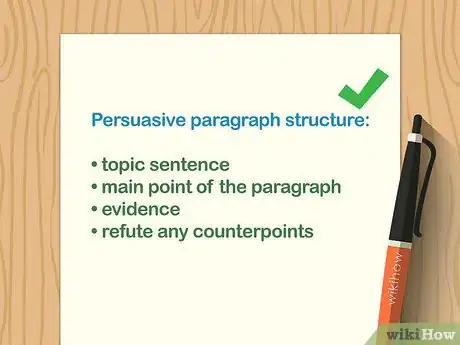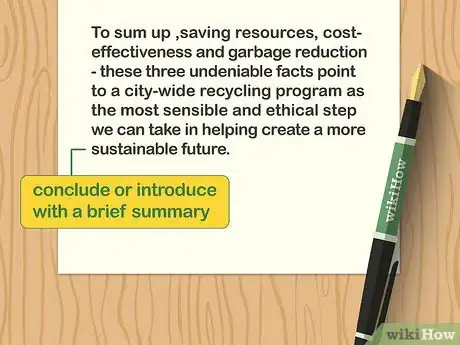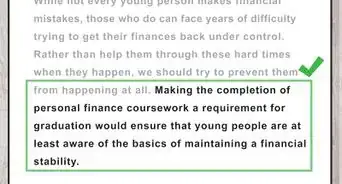This article was co-authored by Christopher Taylor, PhD. Christopher Taylor is an Adjunct Assistant Professor of English at Austin Community College in Texas. He received his PhD in English Literature and Medieval Studies from the University of Texas at Austin in 2014.
This article has been viewed 63,078 times.
A persuasive paragraph can be a standalone assignment, or you might need to write several persuasive paragraphs as part of an essay. The basic format of a persuasive paragraph is the same either way, but there are some additional considerations if you need to write the paragraph as part of a larger essay. Start by planning out the content of the paragraph, then draft the paragraph and include additional details if needed.
Steps
Getting Your Main Point Across
-
1Choose a topic that has at least 2 opposing sides. A persuasive paragraph needs to convince your reader to agree with your position, so you need a topic that allows you to take a stance on an issue. Pick a topic that's debatable, meaning people can disagree about it.[1]
- For instance, topics like "should students be allowed to wear hats in schools," "is social media a bad influence on teens," and "is recycling the best way to help the environment" are all debatable topics that have more than 1 opposing side.
-
2Take a stance on the topic so you can persuade your reader. Make a few notes about what your paragraph needs to cover. Your stance or position is what you will be trying to persuade readers about, and it needs to be focused. Don’t try to express 2 separate opinions in a persuasive paragraph. Focus on a single idea. Think about what stance you will express in the paragraph and make a few notes about your position. If you are writing a paragraph for an assignment, make sure to follow the assignment’s instructions carefully.[2]
- For example, if you need to write a paragraph about what you think is the best holiday, then make a list of your favorites to help you decide.
- If the paragraph will be part of a larger essay, then identify 1 of the points you want to make with the paragraph. This point should support your essay's overall argument.
Advertisement -
3Support your stance with evidence. A persuasive paragraph provides a position in the first sentence, and then goes on to expand on the evidence to support that position. Take a moment to list all of the evidence that explains why you hold the opinion that you do.[3]
- For example, if you want to argue that Halloween is the best holiday of the year, then you might include reasons like getting to wear a costume, trick-or-treating, and eating candy.
- If the paragraph is part of a larger essay, then make a list of the reasons that support your topic sentence. For example, if the essay is about the importance of recycling, then your reasons might include reducing waste, saving energy, and conserving resources.
-
4Create a topic sentence using your subject and opinion. Writing a topic sentence is essential for letting your readers know what the paragraph is about. The topic sentence for a persuasive paragraph should express the subject of the paragraph and your stance on the subject.[4]
- For example, in a paragraph about your favorite holiday, you might simply start with, “Halloween is the best holiday because it is filled with fun activities.”
- In a larger essay, identify what each paragraph will cover and write a separate topic sentence for each paragraph.
Supporting Your Main Point
-
1Include examples that strengthen the paragraph. If you need to use research for your persuasive paragraph or essay, find examples from secondary sources that will support your stance. You can use information from books, newspaper articles, government websites, and other trustworthy sources to provide examples and support for your argument.[5]
- For example, if you are arguing that Halloween is the best holiday, then you might cite candy sales statistics as good for the economy. You could also do a survey of your classmates to see how Halloween stacks up against other holidays in their opinions.
- If you are including a persuasive paragraph as part of a larger essay, then you may want to visit your school’s library to conduct your research. Talk to the librarian if you need help navigating the library’s resources.
Tip: Keep in mind that research is usually not required for a standalone persuasive paragraph assignment, but you can always check with your teacher to be sure!
-
2Outline the reasons you will include in the paragraph. The paragraph should also cover the reasons why you hold the opinion that you do. These reasons will come after the topic sentence. Try to stick to no more than 3 reasons for a paragraph. If you find it hard to do this, then you might need to narrow your subject for the paragraph.[6]
- For example, in a paragraph about why Halloween is the best holiday, you could include reasons like the costumes, trick-or-treating, and candy.
- Use the same strategy for a larger essay. Build on your topic sentence with additional sentences that cover the reasons.
Tip: Don’t worry if your paragraph seems short or a little disorganized at first. You can always read through it again and reorganize or add more detail as needed.
-
3Incorporate details that will capture your reader’s attention. A good persuasive paragraph should be interesting enough that people will want to read it. Think about what the most interesting aspects of your topic are and how you might sprinkle some of that information into each paragraph of an essay or into a single paragraph.[7]
- For example, if you are writing about your favorite holiday, then you might talk a little about that holiday’s history and how it has evolved over the years.
Writing the Rest of Your Persuasive Essay
-
1Place your thesis statement at the end of the introduction. If you are writing an introductory paragraph for a persuasive essay, then you will also need to include a thesis statement. A thesis expresses the main point of your entire essay in a single sentence. Include an explanation of the subject of your essay and your overall stance on the subject.[8]
- For example, in an essay about why local honey is beneficial for immune health, you might start with a thesis that reads, “Eating local honey is better than eating honey from other regions since local honey helps you stay healthier all year long.”
-
2Provide context for readers to help them understand your stance. In some cases, you may need to define special terms for your readers to help them understand the subject matter and see your side of things. The introductory paragraph of an essay will usually require some context to help orient readers to the topic, and you might also need to include a bit of context for individual paragraphs in an essay.[9]
- For example, in an essay about why people should vote in their countries’ elections, you might include background information about how certain populations have been excluded from voting and had to fight for the right to so.
-
3Try to address potential counter arguments in a rebuttal paragraph. Your argument will be stronger if you address and dismiss the opposing arguments. Make a list of the potential arguments that an opponent could make against your stance. Then, find evidence that refutes those arguments. Write a paragraph that acknowledges the opposing argument, then explains the evidence for why your stance is correct.[10]
- If you're having trouble identifying an opposing argument, do some additional research to find different ideas about your topic.
- For instance, let's say you're writing an essay arguing that students shouldn't wear hats in school because they're a distraction. Your topic sentence for your rebuttal paragraph might read like this: "Although hats allow students to express their personal style, they reduce student engagement by 25%."
-
4Summarize the rest of the essay for an introduction or conclusion. When writing an introductory or concluding paragraph for a persuasive essay, it is often helpful to provide readers with a brief summary of the content of the rest of the essay. This can help to orient readers to the topic in the introduction and remind them of the essay’s main points in the conclusion.[11]
- For example, if you are writing about the beneficial properties of green tea, then you might open with a brief summary of how consuming green tea can help people. Then, you could conclude your essay by briefly recapping the main benefits of green tea.
Tip: Be careful not to repeat the points you make in an essay word-for-word if you use summaries. Write the summaries so that they use different language than other parts of your essay.
References
- ↑ https://www.grammarly.com/blog/persuasive-writing/
- ↑ https://opentextbc.ca/buildingblocks/chapter/persuasive-paragraphs/
- ↑ https://opentextbc.ca/buildingblocks/chapter/persuasive-paragraphs/
- ↑ https://www.hamilton.edu/academics/centers/writing/writing-resources/persuasive-essays
- ↑ https://writingcenter.unc.edu/tips-and-tools/paragraphs/
- ↑ https://valenciacollege.edu/students/learning-support/winter-park/communications/documents/ElementsofPersuasive.pdf
- ↑ https://www.hamilton.edu/academics/centers/writing/writing-resources/persuasive-essays
- ↑ https://www.grammarly.com/blog/persuasive-writing/
- ↑ https://www.hamilton.edu/academics/centers/writing/writing-resources/persuasive-essays




































































